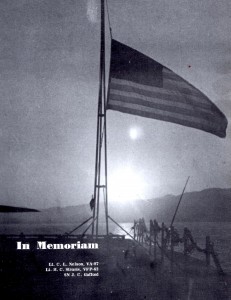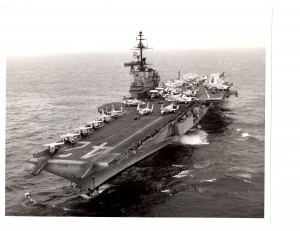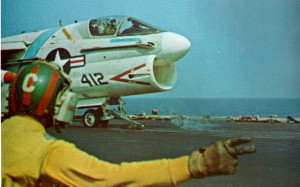 Today’s post was submitted by an old friend, Robert Schnell of Redding, California. Bob was a Radar Intercept Officer in the early 1970s, flying F-4 Phantoms with U.S. Navy Fighter Squadron 84 assigned to the aircraft carrier Franklin D. Roosevelt (CVA-42). I’ll let Bob tell the rest of his story…
Today’s post was submitted by an old friend, Robert Schnell of Redding, California. Bob was a Radar Intercept Officer in the early 1970s, flying F-4 Phantoms with U.S. Navy Fighter Squadron 84 assigned to the aircraft carrier Franklin D. Roosevelt (CVA-42). I’ll let Bob tell the rest of his story…
“The flight deck of a U.S. Navy aircraft carrier has been described as the most dangerous square footage you may trod. During flight operations ear-splitting jet engine noise, aircraft in motion, searing exhaust, jet engine intake forces so powerful it can suck a 200 pound man off the deck in a split second, spinning propellers and flight deck personnel moving among all this machinery on a confined area of about an acre in size demand a careful, deliberate choreography. It takes professional skill, knowledge and no small ability for all this activity to occur so as to get the primary mission accomplished: launching aircraft off the ship and into the air safely and efficiently. Recovery of those same aircraft during the landing sequence has its own set of rules. Even when all is done properly, as safely as possible and as efficiently as only time, training and practice may allow there still is the unknown, unforeseen circumstance that causes tragedy. Such was the case on board the USS Franklin Roosevelt aircraft carrier (FDR), CVA-42, in 1972 during a Sixth Fleet cruise in the Mediterranean Sea.
VFP-63 was a photo reconnaissance squadron flying RF-8’s which were unarmed Crusaders re-equipped with photo gear. The F-8 was equipped with an ejection seat that only promised a safe ejection if the plane was flying at least 200 feet above the surface and at a speed of at least 200 knots. It needed that much speed and altitude for the seat to function properly. The F-4’s ejection seat, by contrast, had a later model “0-0” seat; i.e., one could eject from the Phantom on the ground with no altitude or airspeed necessary. During an otherwise normal launch of an RF-8, one of those unforeseen acts happened. The plane was accelerating down the deck being pulled by the catapult. Then a portion of the underside where the catapult bridle attaches to the plane broke away. The plane was going about 100 knots and was about half the distance to the bow of the ship: moving too fast to brake and too slowly to get airborne. Without a more up-to-date ejection seat there was no way for the pilot to survive an attempted ejection. So he rode the plane until it fell over the bow into the water and was run over by the carrier. There was no hope of recovery. Lt. M.C. Steams was lost at sea.
The other accident involved an A-7 Corsair II from Attack Squadron 87 (VA-87). It also happened during a catapult launch sequence. In the Mediterranean during the summer the air is hot and humid. When a jet goes to 100% power for the catapult launch it also starts to pressurize the cockpit. Through a here-to-fore unknown set of climate-control switch positions the compression of the air inside the cockpit caused the humid ambient air to lower to the dew point where it turned instantaneously into fog. This blinded the pilot and he flew off the deck right-wing down and into the water. If he had any time to blow the canopy will never be known. It all happened in less than 5 seconds. Again, there was no hope of recovery. Lt. C.L. Nelson was also lost at sea.
Those involved in Naval Aviation who lose their lives in the performance of their duties, whether in peace or war, will always be remembered. In these two cases their coffins are the planes they flew, their tombstones are the waves of the Sea above and their memorials are the people who will never forget their ultimate sacrifice.”



Howard Gene Newton said:
I was on the Roosevelt in 72 attached to VF84 an AME. A country boy from North Carolina the furthest I had been from home before the Navy was Myrtle Beach. I would have to say being in the Navy gave me some of the best memories of my life.If I had it to do over I would do it again.
Gene Newton
Harris tackett said:
I filmed the crash of the a-7 from observation deck forward.from leaving the flight deck to sitting in the sea as the carrie passed .super8 kodak film cartridge was taken by officer. Ams 3 Tackett vf-41?
Dave Fincher said:
I was in VF-84 and on the ten month Med cruise in 1972. I was a plane captain and on the flight deck for the turn of twelves. I remember the F-8 scooting down the deck on the port cat and going over the bow. I also seem to remember a F-8 or an A-7 going in the water off the starboard cat because of a starboard wing tank not being fueled and the pilot not compensating for it.
Eddie Spirito said:
I was in V-4 Division (fuels)and did the ’71 cruise. Like Howard said in his post above, if I could do it again, I would.
Bob’s description of the havoc on deck was about right. I did 2 years at a NAS prior to Rosie, which at least gave me a “heads up”, but guys right out of boot camp up on deck is nuts. Our officers allowed the guys from the pump rooms go up on deck for the minimum amount of time just to receive the extra flight deck pay. I didn’t like being around them for the simple fact that they were a tremendous liability. I watched a plane captain get blown into a prop because he walked behind the A7 that I was refueling, thinking that it was shut down like they are at air stations. He didn’t know because he’s not up there that often. He tripped and fell on his back just as he came to the prop, and lost both legs at the knees. I always thought, and I believe that I’m right, that I had an edge because I did 2 years at an NAS first.
Tom brown said:
I was on the Med. cruise of ‘67-‘68. Does anybody remember the incident with one of the RIO’s that was lost at sea? I believe he was a Top Hatter. Our cruise book was dedicated to him. He was a very nice officer and I think of him from time to time.Just let me know.
Rene’ Ferrell said:
I was aboard for the 72 Med cruise attached to VA-15 as an AT2. I remember both accidents and while I didn’t actually see them happen, I remember seeing the young LT. preflighting his F8 on the flight deck. As I recall, both accidents happened within a short period of time, after which there was a safety stand down. R.I.P. Sirs!
Mike Dalton said:
I was onboard, remember both accidents, they happened on the 4th and 5th day at sea. I was TAD to S-1 Div. From VF-84 as a supply runner. later in the cruise a shipmate either fell or jumped overboard at night, and was never recovered.
Michael Luich said:
We had a soft cat on the Roosevelt with an A3 around 1970. I remember our VQ2 squadron lost 6 people. The plane captain was the only survivor. He was thrown away from the plane while trying to get out of his hatch, suffered 2 broken legs but lived. Several of the crew were guests, wanting to get a ride. This tragedy was in the Stars n Stripes If my memory is correct.